Evaluation of Public Health Approaches in India and USA for Malaria Eradication
VerifiedAdded on 2023/01/20
|26
|2332
|45
Presentation
AI Summary
This presentation evaluates the success of public health approaches in India and USA for malaria eradication, including interventions, challenges, and cultural competence. It also discusses the utilization of qualitative and quantitative methodologies in global health research on malaria.
Contribute Materials
Your contribution can guide someone’s learning journey. Share your
documents today.

Global public health
Students Name
Students Name
Secure Best Marks with AI Grader
Need help grading? Try our AI Grader for instant feedback on your assignments.
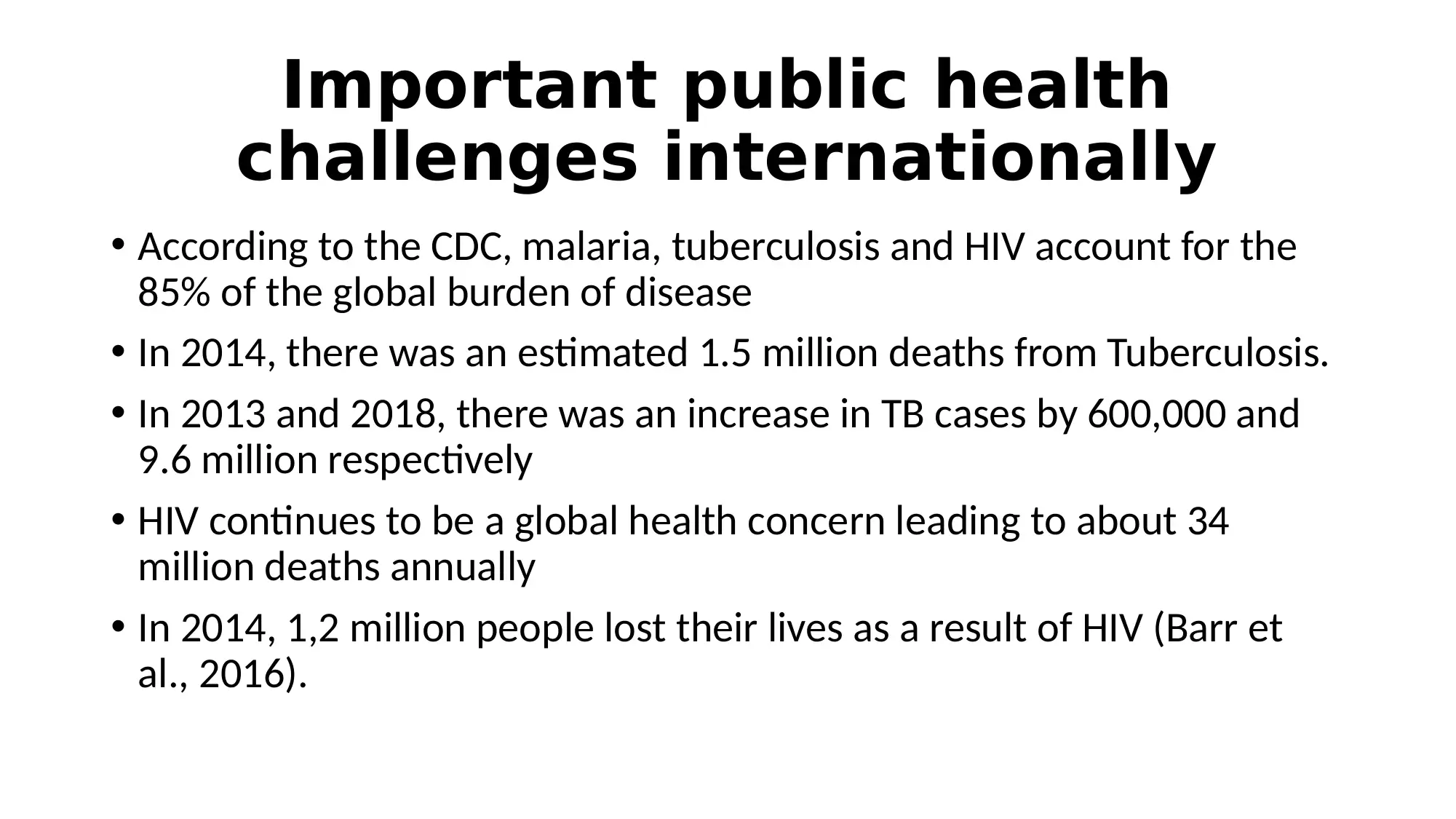
Important public health
challenges internationally
• According to the CDC, malaria, tuberculosis and HIV account for the
85% of the global burden of disease
• In 2014, there was an estimated 1.5 million deaths from Tuberculosis.
• In 2013 and 2018, there was an increase in TB cases by 600,000 and
9.6 million respectively
• HIV continues to be a global health concern leading to about 34
million deaths annually
• In 2014, 1,2 million people lost their lives as a result of HIV (Barr et
al., 2016).
challenges internationally
• According to the CDC, malaria, tuberculosis and HIV account for the
85% of the global burden of disease
• In 2014, there was an estimated 1.5 million deaths from Tuberculosis.
• In 2013 and 2018, there was an increase in TB cases by 600,000 and
9.6 million respectively
• HIV continues to be a global health concern leading to about 34
million deaths annually
• In 2014, 1,2 million people lost their lives as a result of HIV (Barr et
al., 2016).
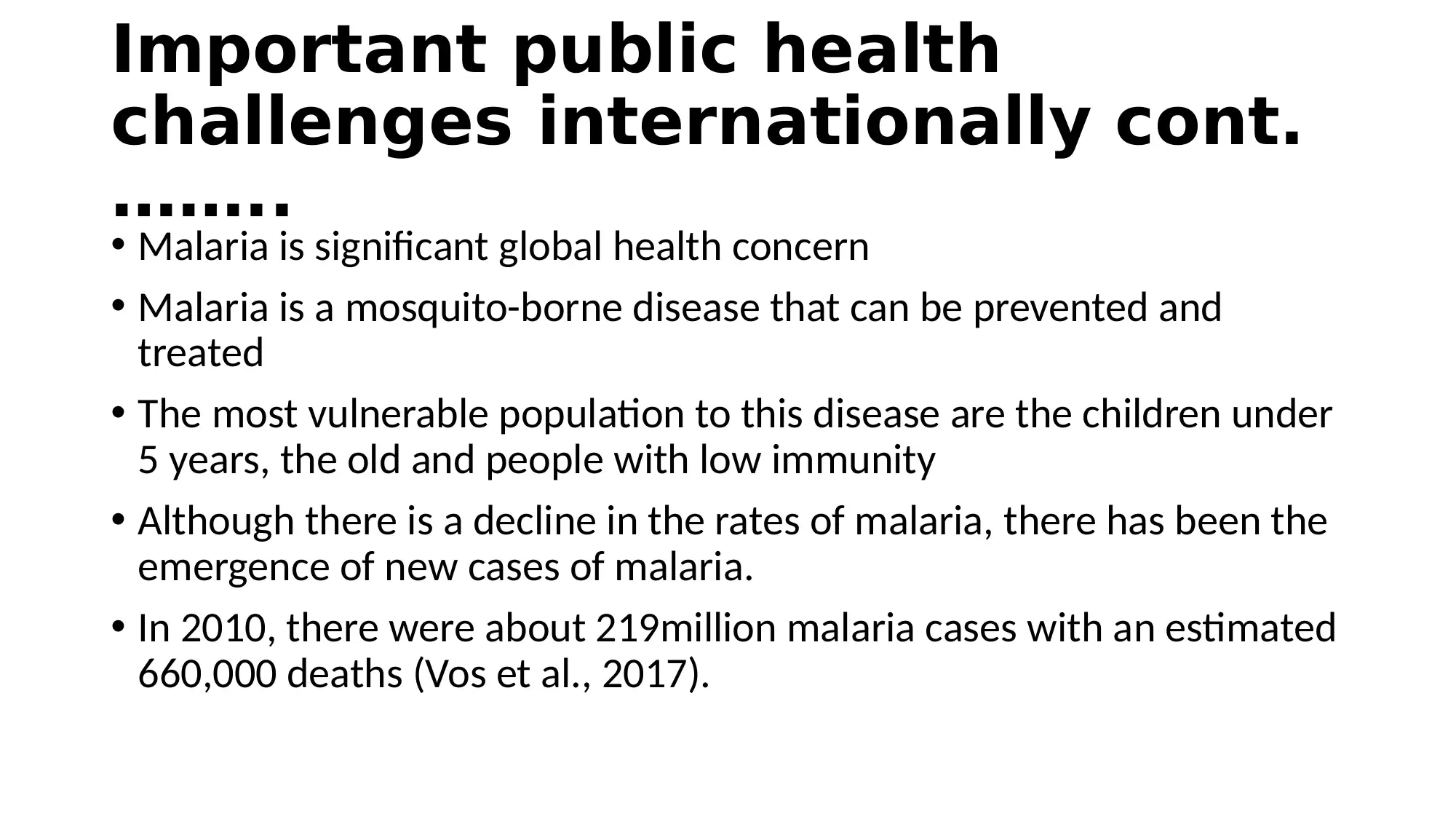
Important public health
challenges internationally cont.
……..
• Malaria is significant global health concern
• Malaria is a mosquito-borne disease that can be prevented and
treated
• The most vulnerable population to this disease are the children under
5 years, the old and people with low immunity
• Although there is a decline in the rates of malaria, there has been the
emergence of new cases of malaria.
• In 2010, there were about 219million malaria cases with an estimated
660,000 deaths (Vos et al., 2017).
challenges internationally cont.
……..
• Malaria is significant global health concern
• Malaria is a mosquito-borne disease that can be prevented and
treated
• The most vulnerable population to this disease are the children under
5 years, the old and people with low immunity
• Although there is a decline in the rates of malaria, there has been the
emergence of new cases of malaria.
• In 2010, there were about 219million malaria cases with an estimated
660,000 deaths (Vos et al., 2017).
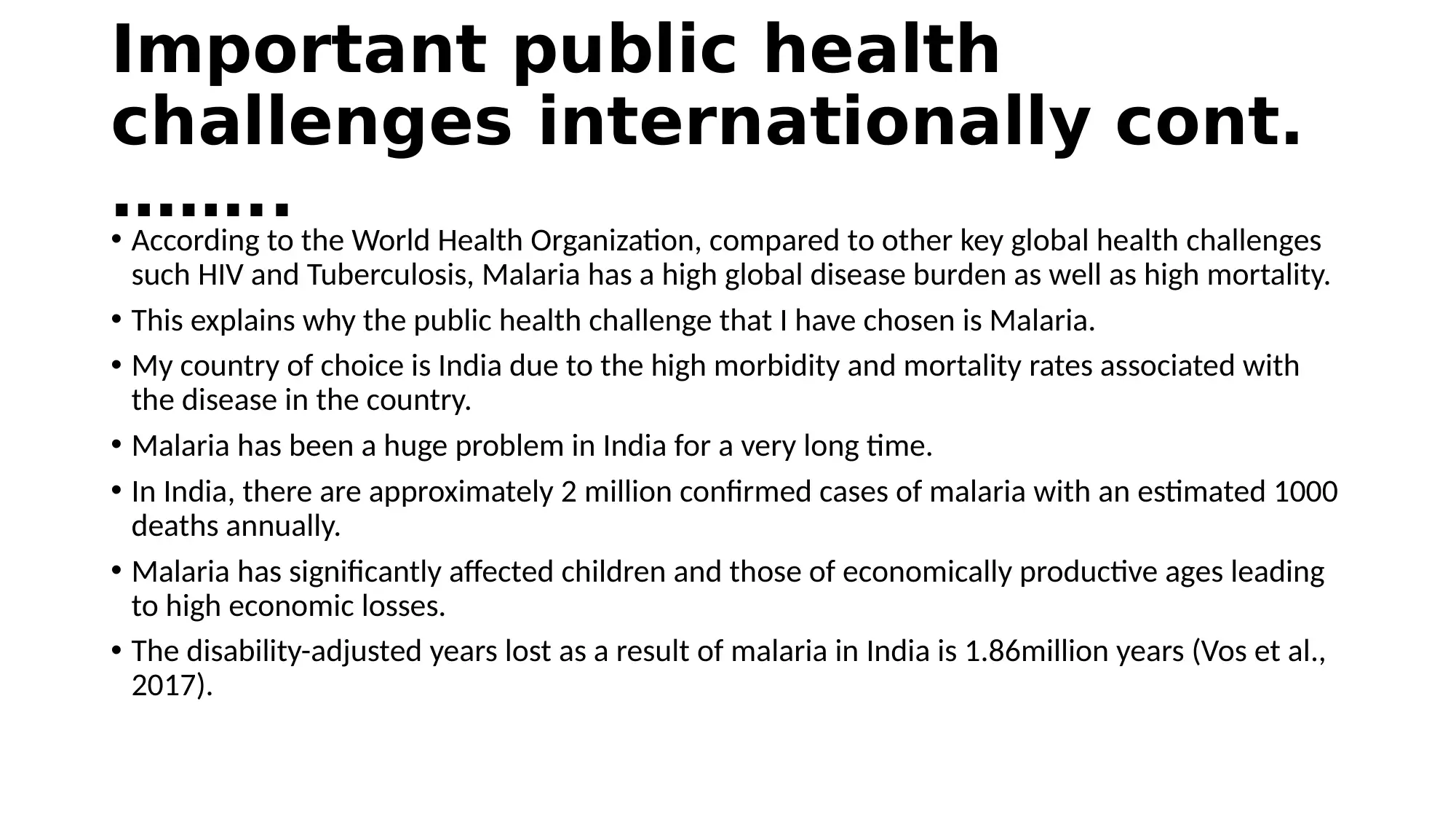
Important public health
challenges internationally cont.
……..
• According to the World Health Organization, compared to other key global health challenges
such HIV and Tuberculosis, Malaria has a high global disease burden as well as high mortality.
• This explains why the public health challenge that I have chosen is Malaria.
• My country of choice is India due to the high morbidity and mortality rates associated with
the disease in the country.
• Malaria has been a huge problem in India for a very long time.
• In India, there are approximately 2 million confirmed cases of malaria with an estimated 1000
deaths annually.
• Malaria has significantly affected children and those of economically productive ages leading
to high economic losses.
• The disability-adjusted years lost as a result of malaria in India is 1.86million years (Vos et al.,
2017).
challenges internationally cont.
……..
• According to the World Health Organization, compared to other key global health challenges
such HIV and Tuberculosis, Malaria has a high global disease burden as well as high mortality.
• This explains why the public health challenge that I have chosen is Malaria.
• My country of choice is India due to the high morbidity and mortality rates associated with
the disease in the country.
• Malaria has been a huge problem in India for a very long time.
• In India, there are approximately 2 million confirmed cases of malaria with an estimated 1000
deaths annually.
• Malaria has significantly affected children and those of economically productive ages leading
to high economic losses.
• The disability-adjusted years lost as a result of malaria in India is 1.86million years (Vos et al.,
2017).
Secure Best Marks with AI Grader
Need help grading? Try our AI Grader for instant feedback on your assignments.
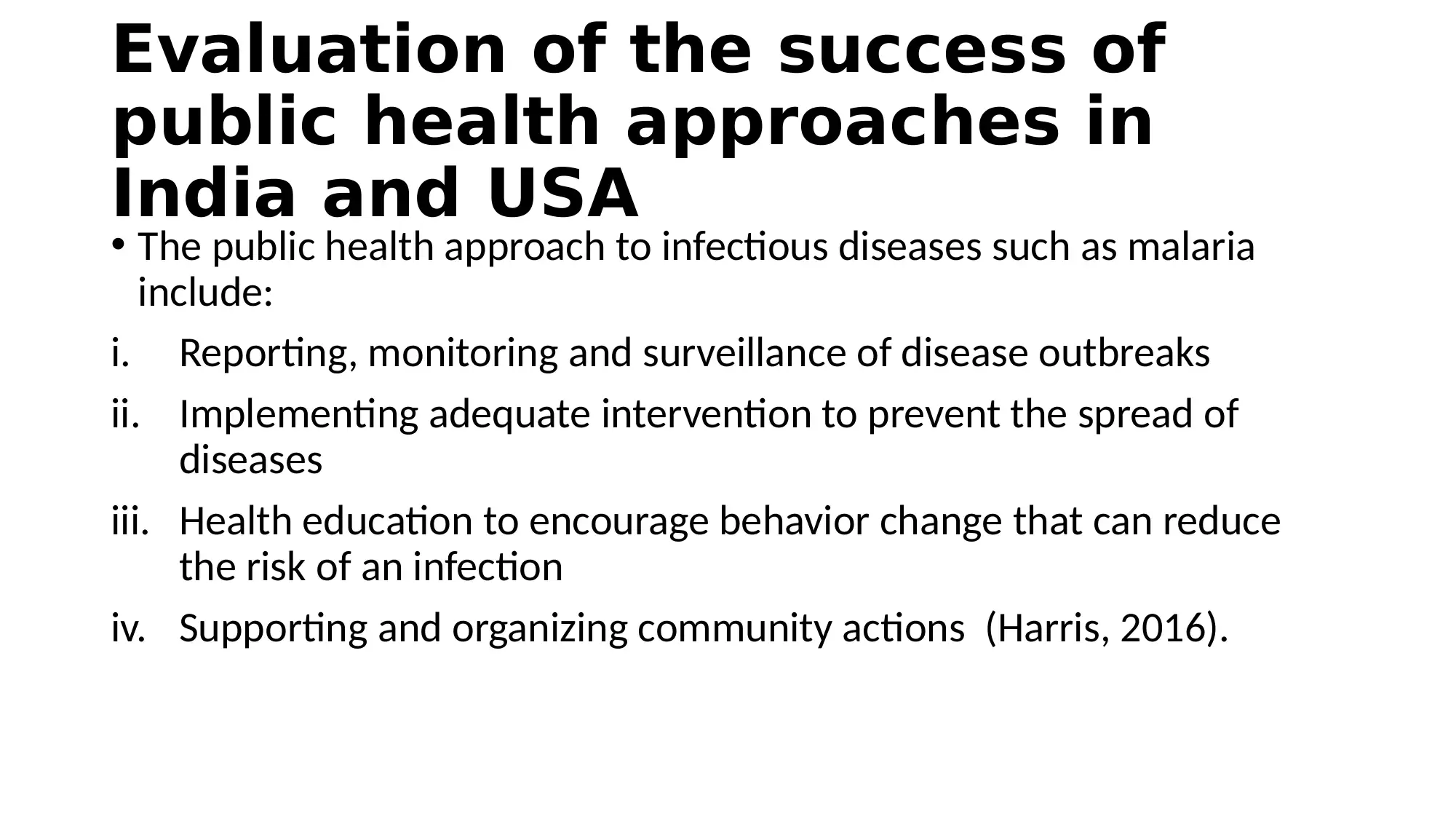
Evaluation of the success of
public health approaches in
India and USA
• The public health approach to infectious diseases such as malaria
include:
i. Reporting, monitoring and surveillance of disease outbreaks
ii. Implementing adequate intervention to prevent the spread of
diseases
iii. Health education to encourage behavior change that can reduce
the risk of an infection
iv. Supporting and organizing community actions (Harris, 2016).
public health approaches in
India and USA
• The public health approach to infectious diseases such as malaria
include:
i. Reporting, monitoring and surveillance of disease outbreaks
ii. Implementing adequate intervention to prevent the spread of
diseases
iii. Health education to encourage behavior change that can reduce
the risk of an infection
iv. Supporting and organizing community actions (Harris, 2016).
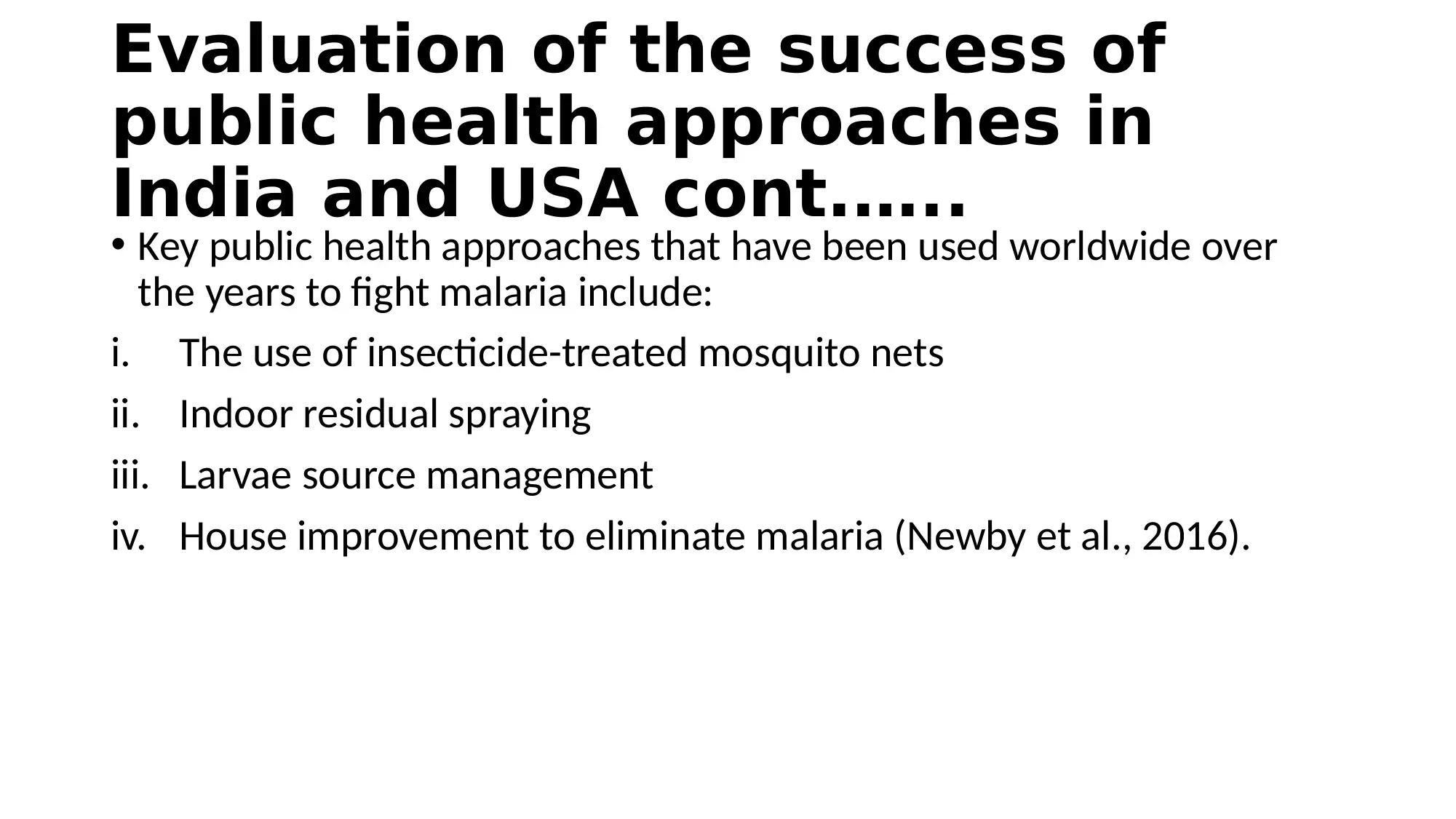
Evaluation of the success of
public health approaches in
India and USA cont.…..
• Key public health approaches that have been used worldwide over
the years to fight malaria include:
i. The use of insecticide-treated mosquito nets
ii. Indoor residual spraying
iii. Larvae source management
iv. House improvement to eliminate malaria (Newby et al., 2016).
public health approaches in
India and USA cont.…..
• Key public health approaches that have been used worldwide over
the years to fight malaria include:
i. The use of insecticide-treated mosquito nets
ii. Indoor residual spraying
iii. Larvae source management
iv. House improvement to eliminate malaria (Newby et al., 2016).
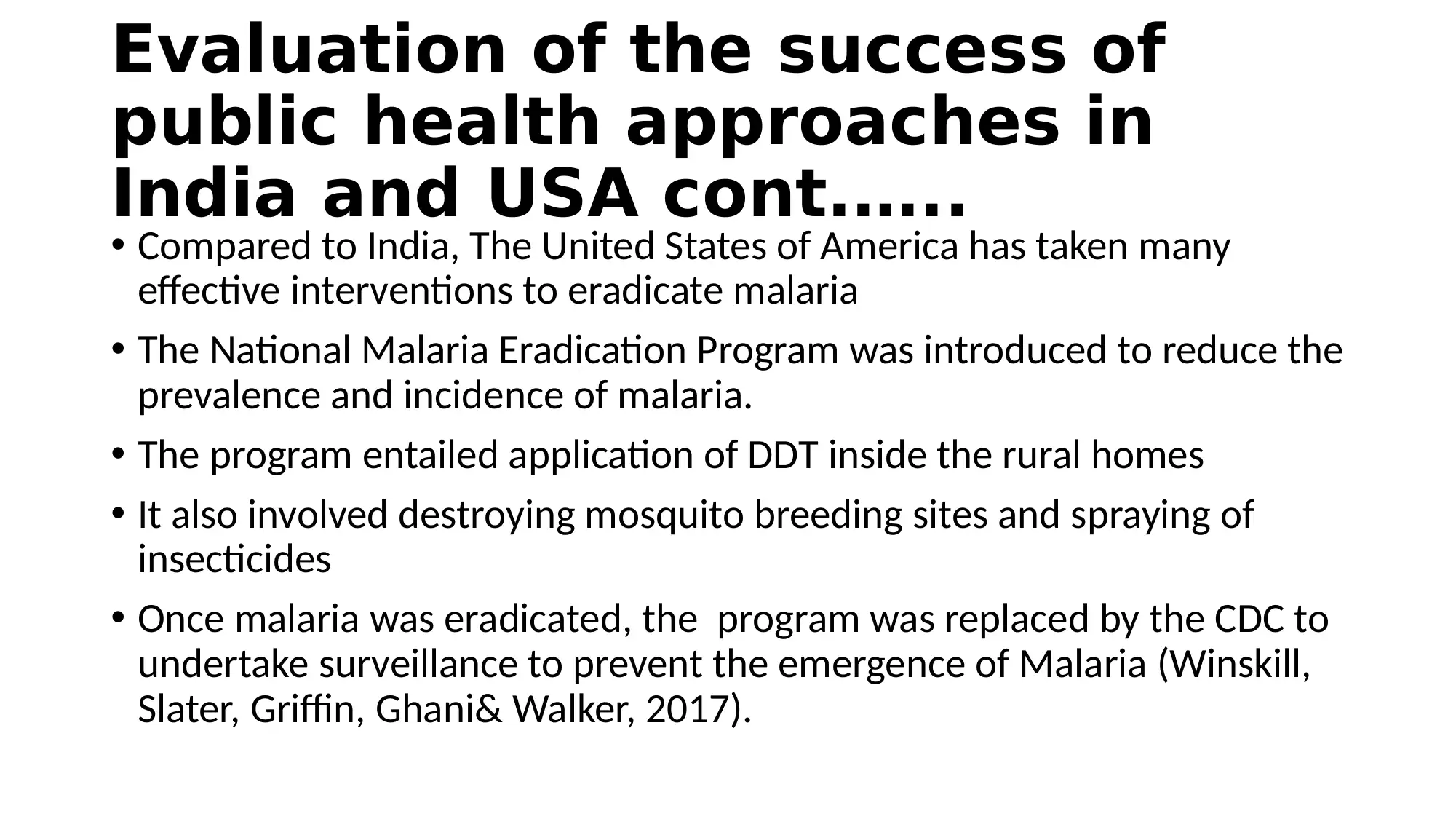
Evaluation of the success of
public health approaches in
India and USA cont.…..
• Compared to India, The United States of America has taken many
effective interventions to eradicate malaria
• The National Malaria Eradication Program was introduced to reduce the
prevalence and incidence of malaria.
• The program entailed application of DDT inside the rural homes
• It also involved destroying mosquito breeding sites and spraying of
insecticides
• Once malaria was eradicated, the program was replaced by the CDC to
undertake surveillance to prevent the emergence of Malaria (Winskill,
Slater, Griffin, Ghani& Walker, 2017).
public health approaches in
India and USA cont.…..
• Compared to India, The United States of America has taken many
effective interventions to eradicate malaria
• The National Malaria Eradication Program was introduced to reduce the
prevalence and incidence of malaria.
• The program entailed application of DDT inside the rural homes
• It also involved destroying mosquito breeding sites and spraying of
insecticides
• Once malaria was eradicated, the program was replaced by the CDC to
undertake surveillance to prevent the emergence of Malaria (Winskill,
Slater, Griffin, Ghani& Walker, 2017).
Paraphrase This Document
Need a fresh take? Get an instant paraphrase of this document with our AI Paraphraser

Evaluation of the success of
public health approaches in
India and USA cont.…..
• The Centre For Disease control has numerous functions which include:
• Monitoring of the distribution and frequency of malaria cases
• Offering adequate information to the public and healthcare providers
regarding how to protect oneself from contracting malaria.
• Offering epidemiological assistance and clinical advice on the
prevention, treatment and control of malaria.
• Investigation of the local outbreaks
• Assessing the global antimalarial drug resistance through surveillance of
U.S malaria cases (Mace, Arguin & Tan, 2018).
public health approaches in
India and USA cont.…..
• The Centre For Disease control has numerous functions which include:
• Monitoring of the distribution and frequency of malaria cases
• Offering adequate information to the public and healthcare providers
regarding how to protect oneself from contracting malaria.
• Offering epidemiological assistance and clinical advice on the
prevention, treatment and control of malaria.
• Investigation of the local outbreaks
• Assessing the global antimalarial drug resistance through surveillance of
U.S malaria cases (Mace, Arguin & Tan, 2018).

Evaluation of the success of
public health approaches in
India and USA cont.…..
• On the other hand, the interventions India has taken to reduce the
burden of malaria include:
i. Enhanced accessibility and quality of health care services
ii. Adoption of effective non-insecticide mosquito control methods
iii. Introduction of medicated mosquito net programs
iv. Adoption of epidemic response and intersectoral collaboration
v. Strengthening of the Institutional component to enhance training
and create awareness through campaigns (Wangdi et al., 2016).
public health approaches in
India and USA cont.…..
• On the other hand, the interventions India has taken to reduce the
burden of malaria include:
i. Enhanced accessibility and quality of health care services
ii. Adoption of effective non-insecticide mosquito control methods
iii. Introduction of medicated mosquito net programs
iv. Adoption of epidemic response and intersectoral collaboration
v. Strengthening of the Institutional component to enhance training
and create awareness through campaigns (Wangdi et al., 2016).
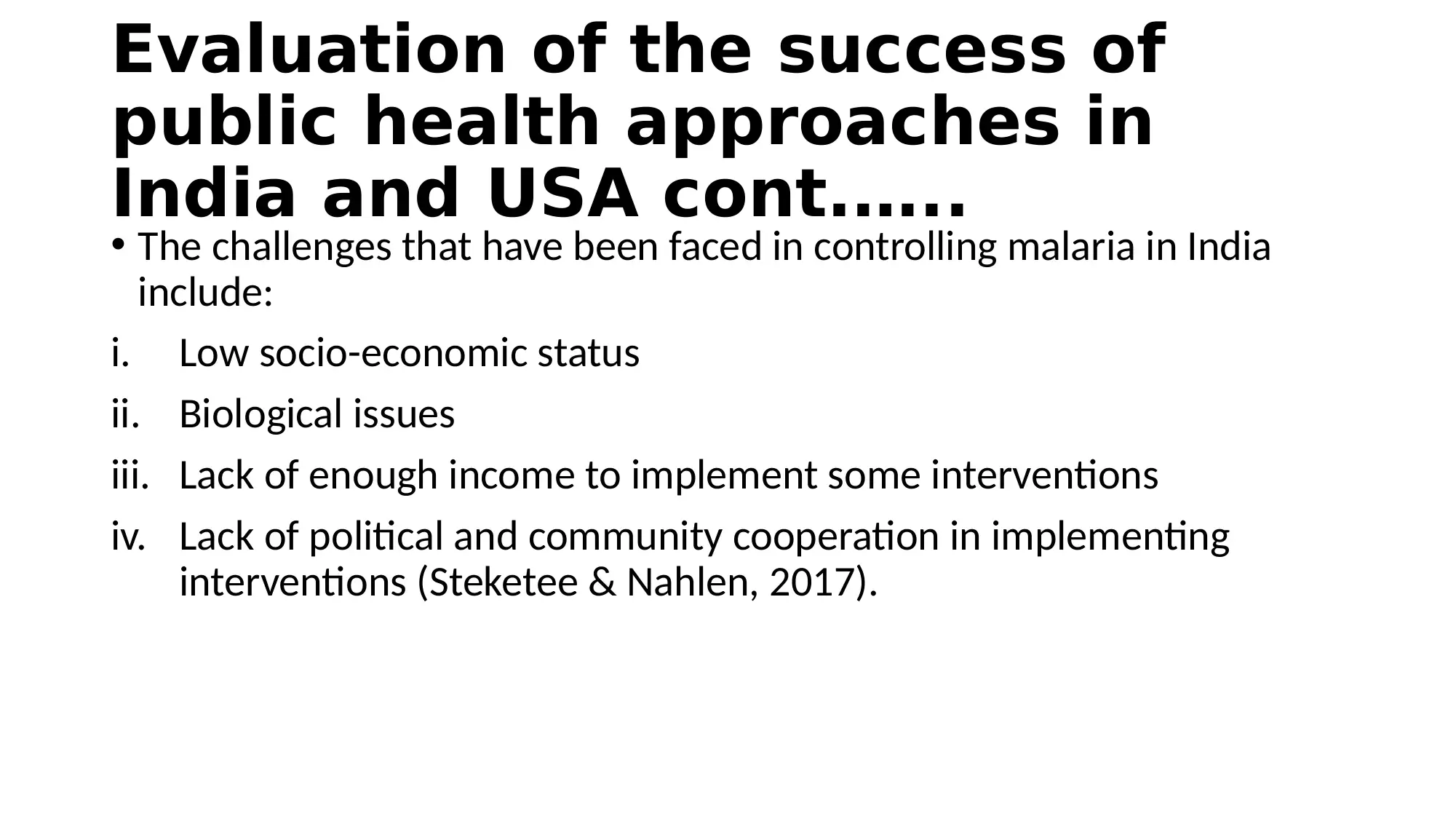
Evaluation of the success of
public health approaches in
India and USA cont.…..
• The challenges that have been faced in controlling malaria in India
include:
i. Low socio-economic status
ii. Biological issues
iii. Lack of enough income to implement some interventions
iv. Lack of political and community cooperation in implementing
interventions (Steketee & Nahlen, 2017).
public health approaches in
India and USA cont.…..
• The challenges that have been faced in controlling malaria in India
include:
i. Low socio-economic status
ii. Biological issues
iii. Lack of enough income to implement some interventions
iv. Lack of political and community cooperation in implementing
interventions (Steketee & Nahlen, 2017).
Secure Best Marks with AI Grader
Need help grading? Try our AI Grader for instant feedback on your assignments.
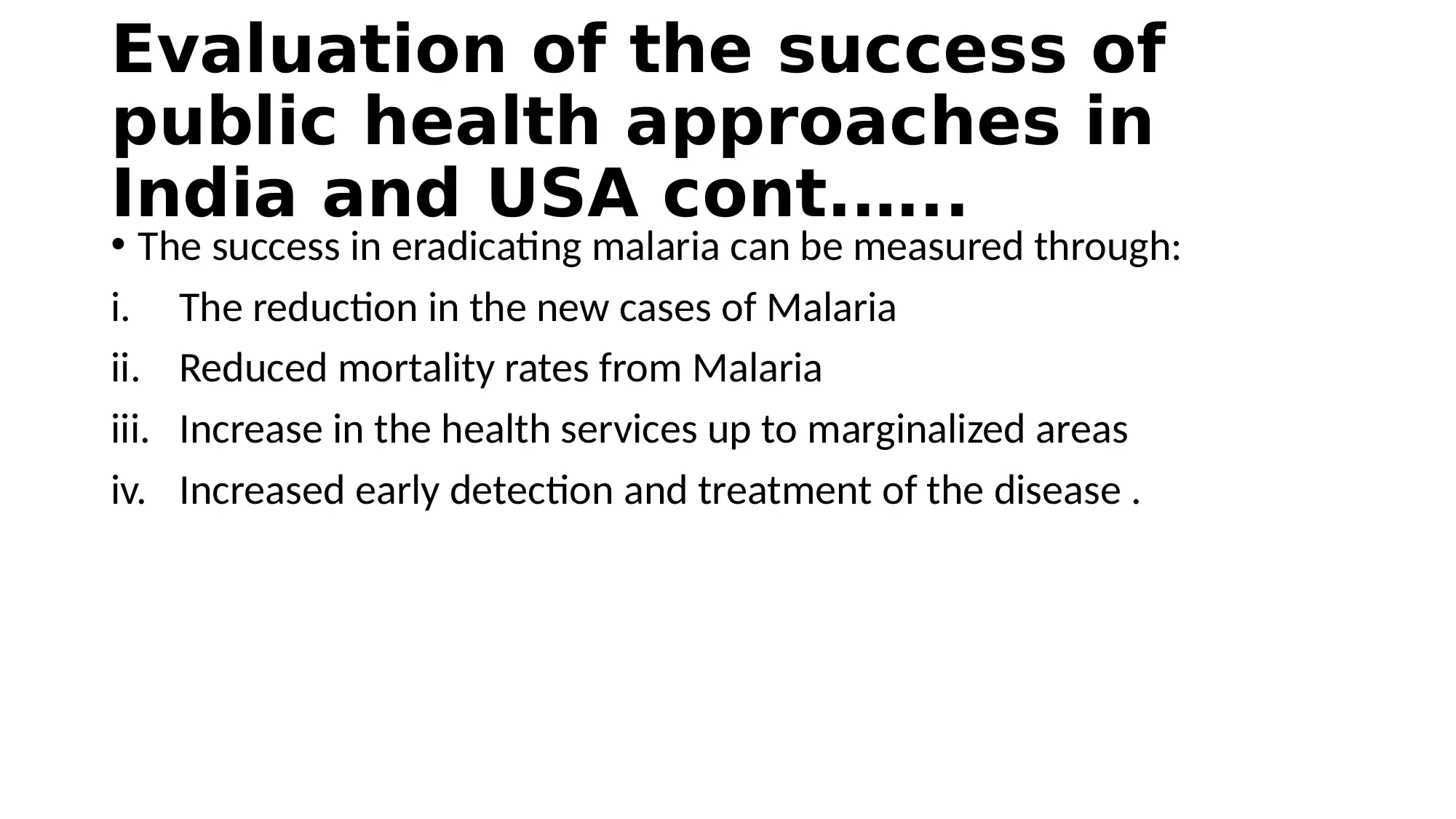
Evaluation of the success of
public health approaches in
India and USA cont.…..
• The success in eradicating malaria can be measured through:
i. The reduction in the new cases of Malaria
ii. Reduced mortality rates from Malaria
iii. Increase in the health services up to marginalized areas
iv. Increased early detection and treatment of the disease .
public health approaches in
India and USA cont.…..
• The success in eradicating malaria can be measured through:
i. The reduction in the new cases of Malaria
ii. Reduced mortality rates from Malaria
iii. Increase in the health services up to marginalized areas
iv. Increased early detection and treatment of the disease .
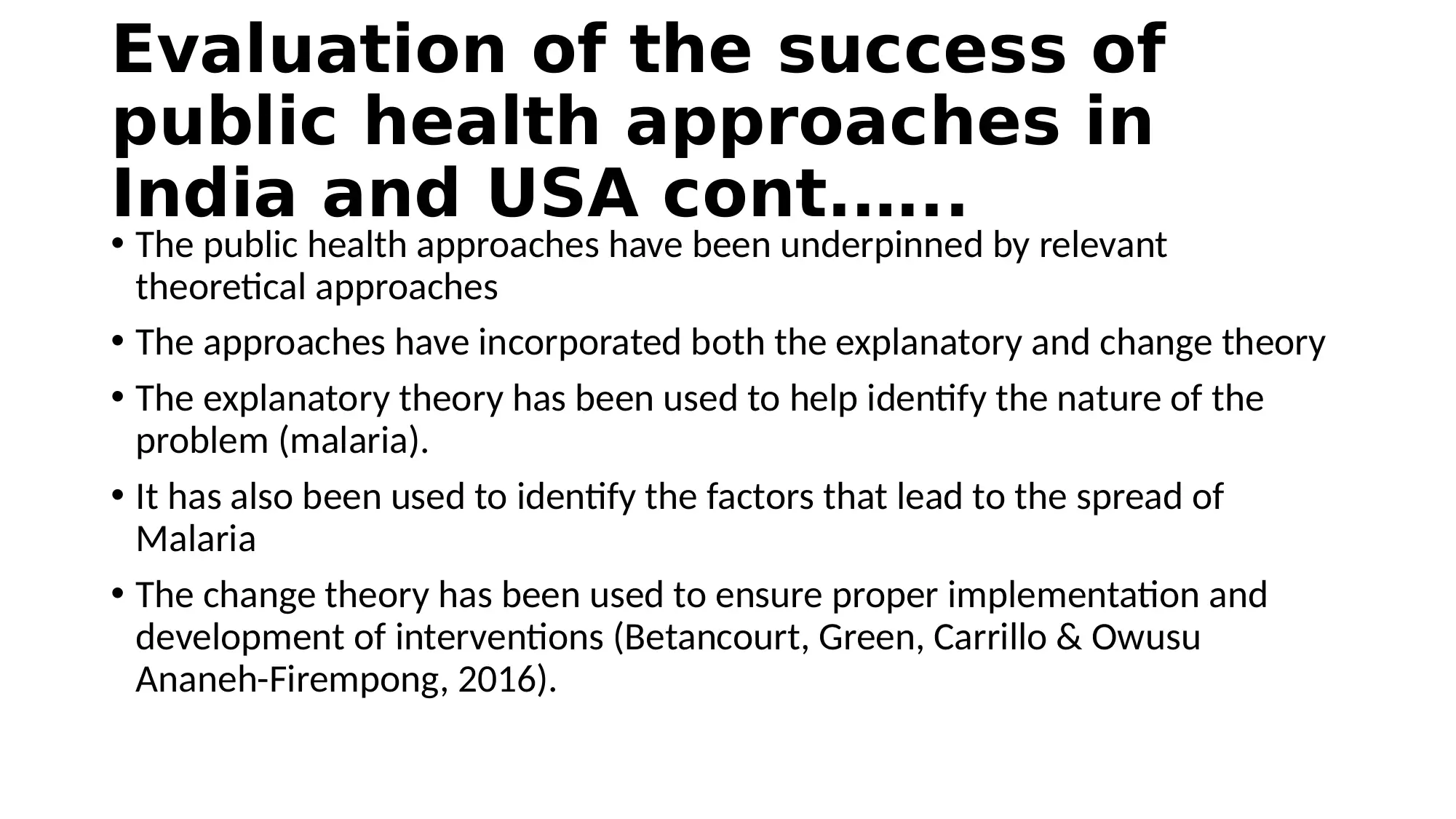
Evaluation of the success of
public health approaches in
India and USA cont.…..
• The public health approaches have been underpinned by relevant
theoretical approaches
• The approaches have incorporated both the explanatory and change theory
• The explanatory theory has been used to help identify the nature of the
problem (malaria).
• It has also been used to identify the factors that lead to the spread of
Malaria
• The change theory has been used to ensure proper implementation and
development of interventions (Betancourt, Green, Carrillo & Owusu
Ananeh-Firempong, 2016).
public health approaches in
India and USA cont.…..
• The public health approaches have been underpinned by relevant
theoretical approaches
• The approaches have incorporated both the explanatory and change theory
• The explanatory theory has been used to help identify the nature of the
problem (malaria).
• It has also been used to identify the factors that lead to the spread of
Malaria
• The change theory has been used to ensure proper implementation and
development of interventions (Betancourt, Green, Carrillo & Owusu
Ananeh-Firempong, 2016).
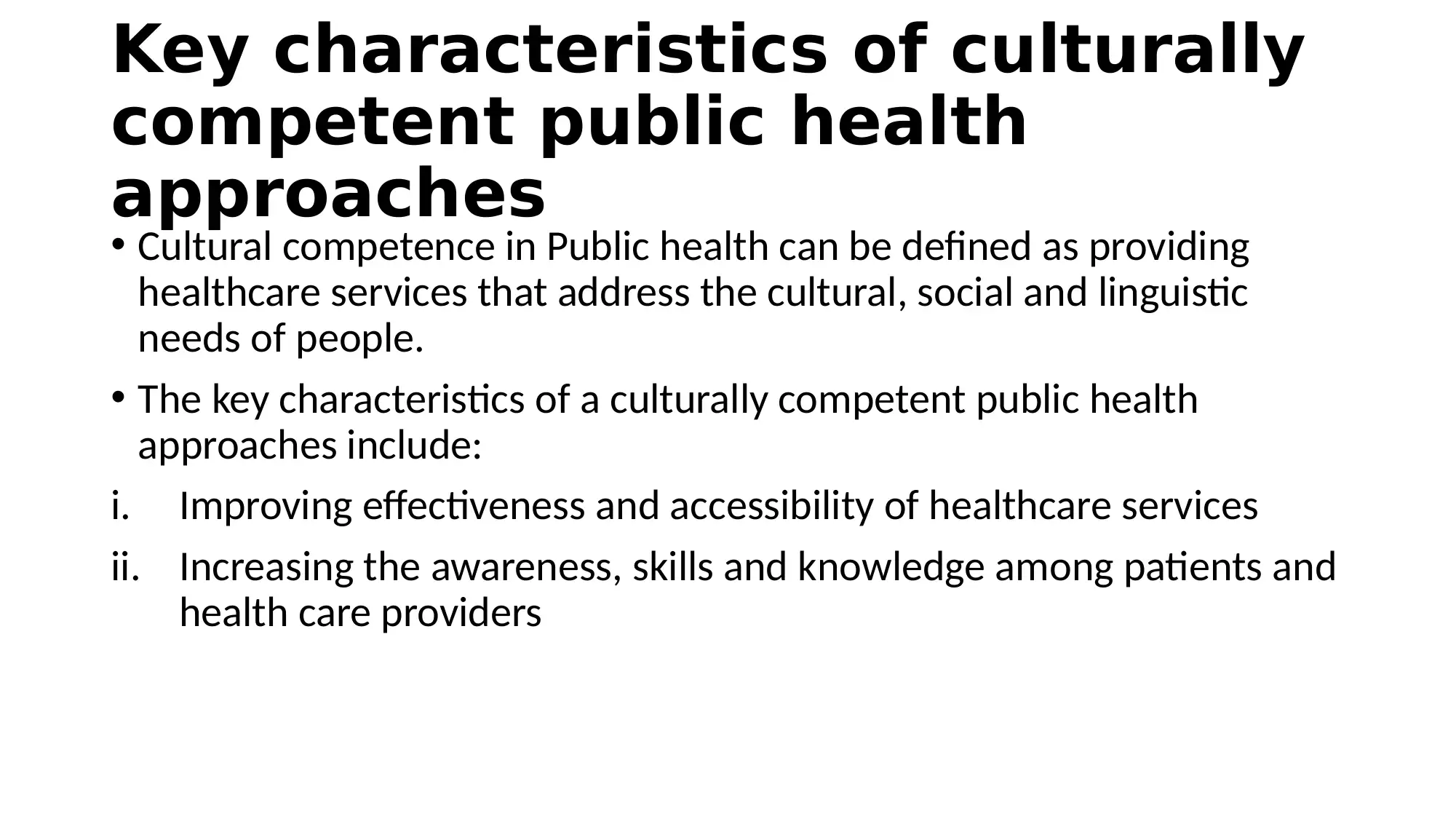
Key characteristics of culturally
competent public health
approaches
• Cultural competence in Public health can be defined as providing
healthcare services that address the cultural, social and linguistic
needs of people.
• The key characteristics of a culturally competent public health
approaches include:
i. Improving effectiveness and accessibility of healthcare services
ii. Increasing the awareness, skills and knowledge among patients and
health care providers
competent public health
approaches
• Cultural competence in Public health can be defined as providing
healthcare services that address the cultural, social and linguistic
needs of people.
• The key characteristics of a culturally competent public health
approaches include:
i. Improving effectiveness and accessibility of healthcare services
ii. Increasing the awareness, skills and knowledge among patients and
health care providers
Paraphrase This Document
Need a fresh take? Get an instant paraphrase of this document with our AI Paraphraser
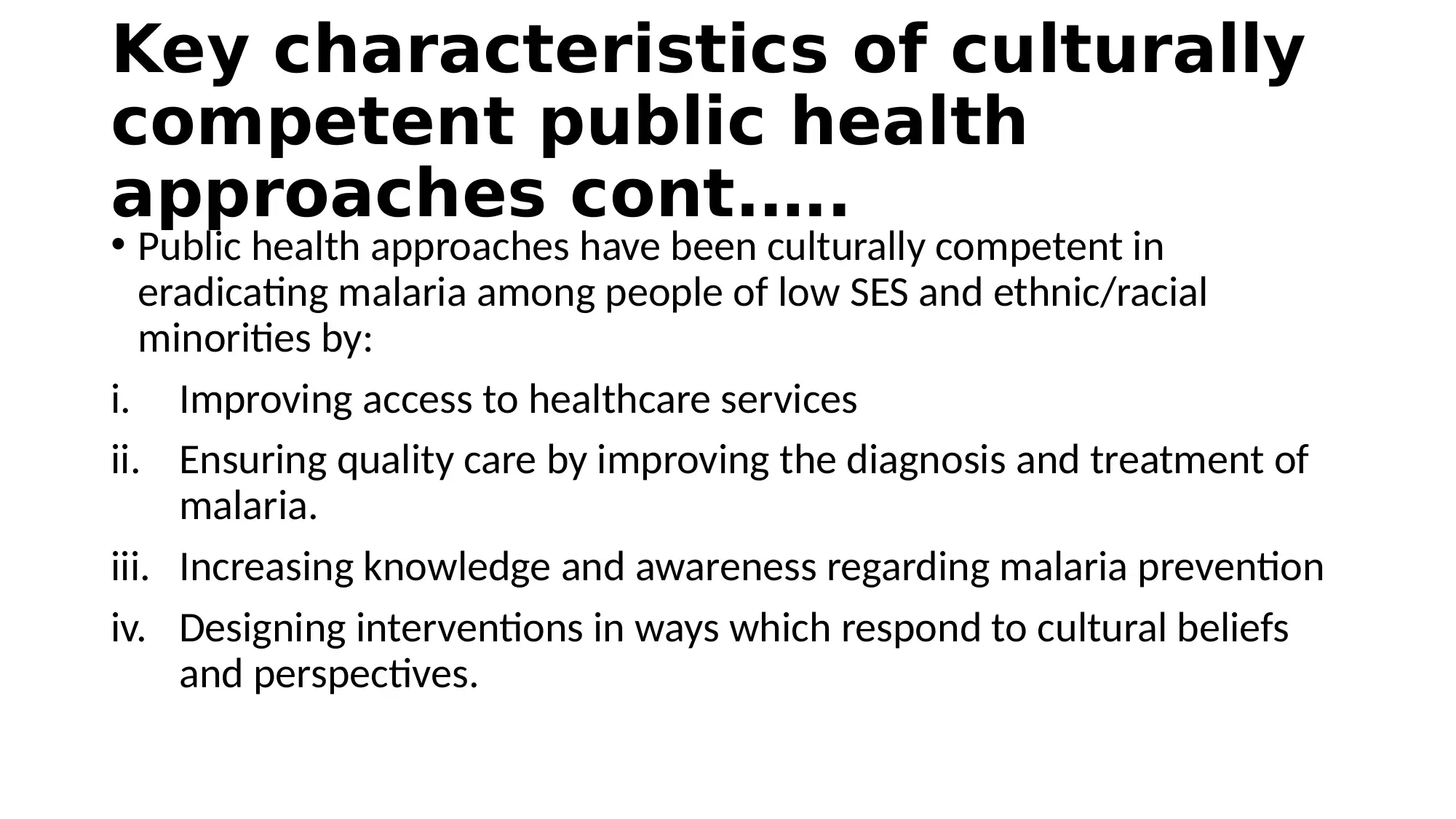
Key characteristics of culturally
competent public health
approaches cont.….
• Public health approaches have been culturally competent in
eradicating malaria among people of low SES and ethnic/racial
minorities by:
i. Improving access to healthcare services
ii. Ensuring quality care by improving the diagnosis and treatment of
malaria.
iii. Increasing knowledge and awareness regarding malaria prevention
iv. Designing interventions in ways which respond to cultural beliefs
and perspectives.
competent public health
approaches cont.….
• Public health approaches have been culturally competent in
eradicating malaria among people of low SES and ethnic/racial
minorities by:
i. Improving access to healthcare services
ii. Ensuring quality care by improving the diagnosis and treatment of
malaria.
iii. Increasing knowledge and awareness regarding malaria prevention
iv. Designing interventions in ways which respond to cultural beliefs
and perspectives.
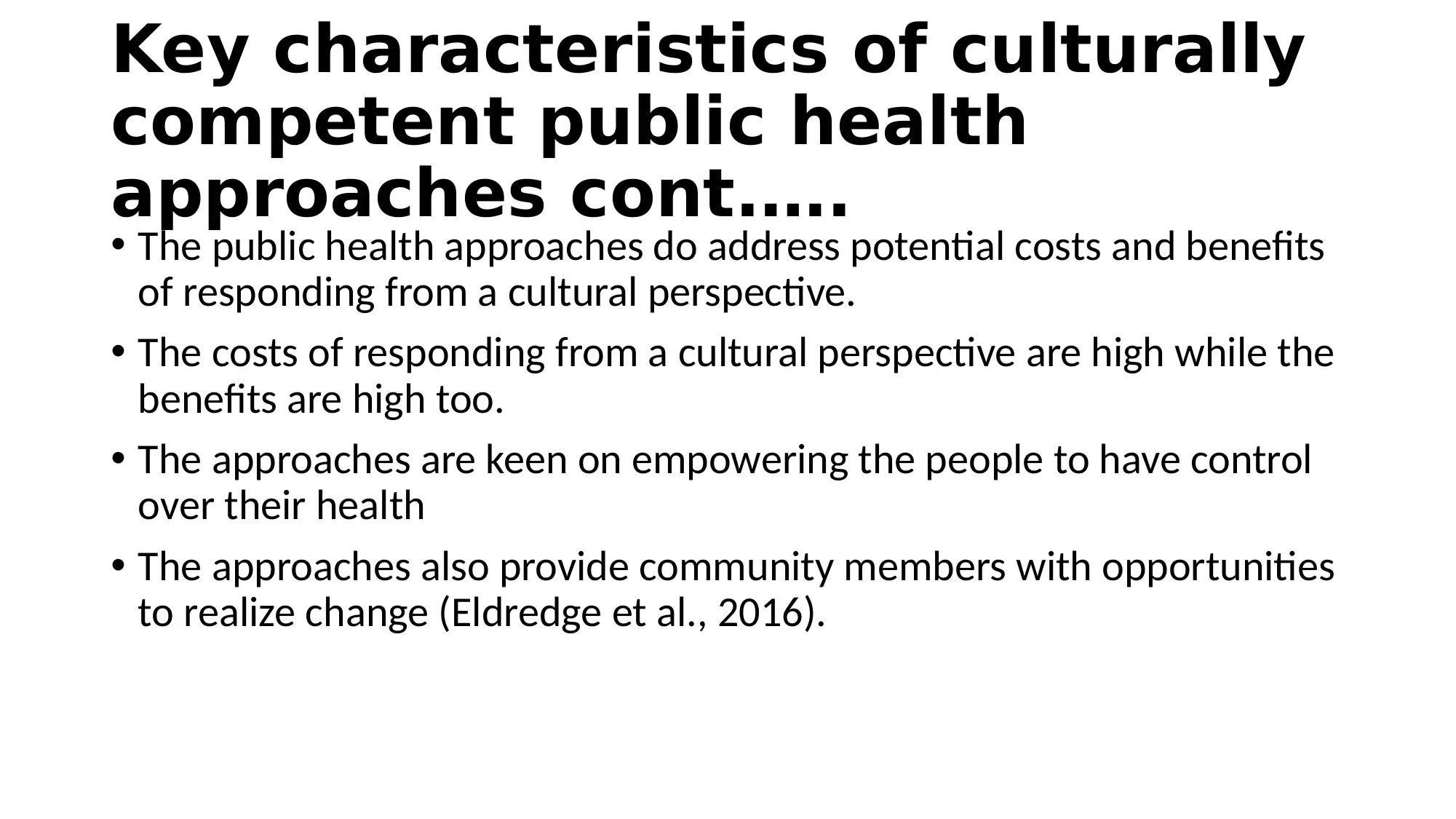
Key characteristics of culturally
competent public health
approaches cont.….
• The public health approaches do address potential costs and benefits
of responding from a cultural perspective.
• The costs of responding from a cultural perspective are high while the
benefits are high too.
• The approaches are keen on empowering the people to have control
over their health
• The approaches also provide community members with opportunities
to realize change (Eldredge et al., 2016).
competent public health
approaches cont.….
• The public health approaches do address potential costs and benefits
of responding from a cultural perspective.
• The costs of responding from a cultural perspective are high while the
benefits are high too.
• The approaches are keen on empowering the people to have control
over their health
• The approaches also provide community members with opportunities
to realize change (Eldredge et al., 2016).
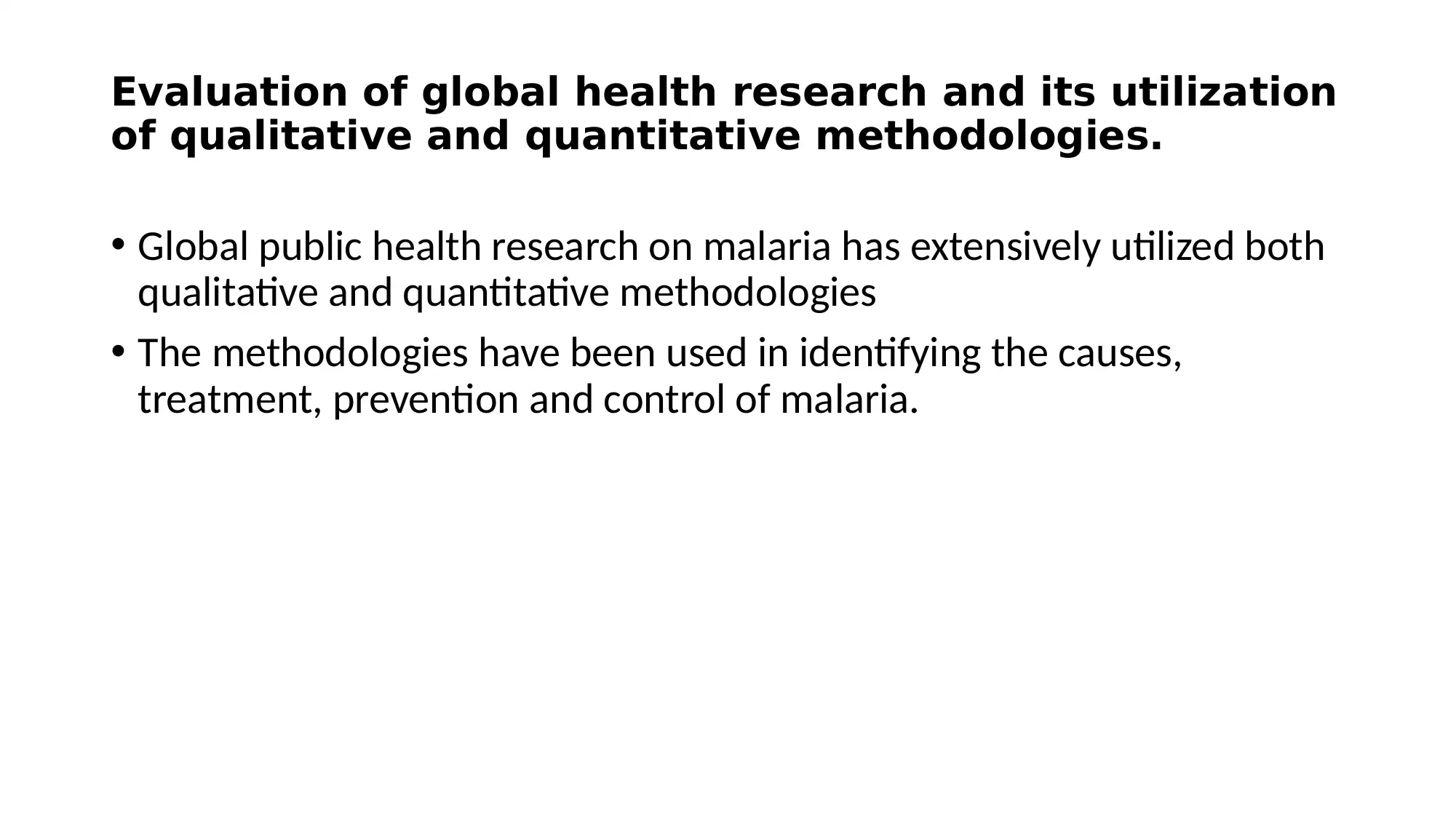
Evaluation of global health research and its utilization
of qualitative and quantitative methodologies.
• Global public health research on malaria has extensively utilized both
qualitative and quantitative methodologies
• The methodologies have been used in identifying the causes,
treatment, prevention and control of malaria.
of qualitative and quantitative methodologies.
• Global public health research on malaria has extensively utilized both
qualitative and quantitative methodologies
• The methodologies have been used in identifying the causes,
treatment, prevention and control of malaria.
Secure Best Marks with AI Grader
Need help grading? Try our AI Grader for instant feedback on your assignments.
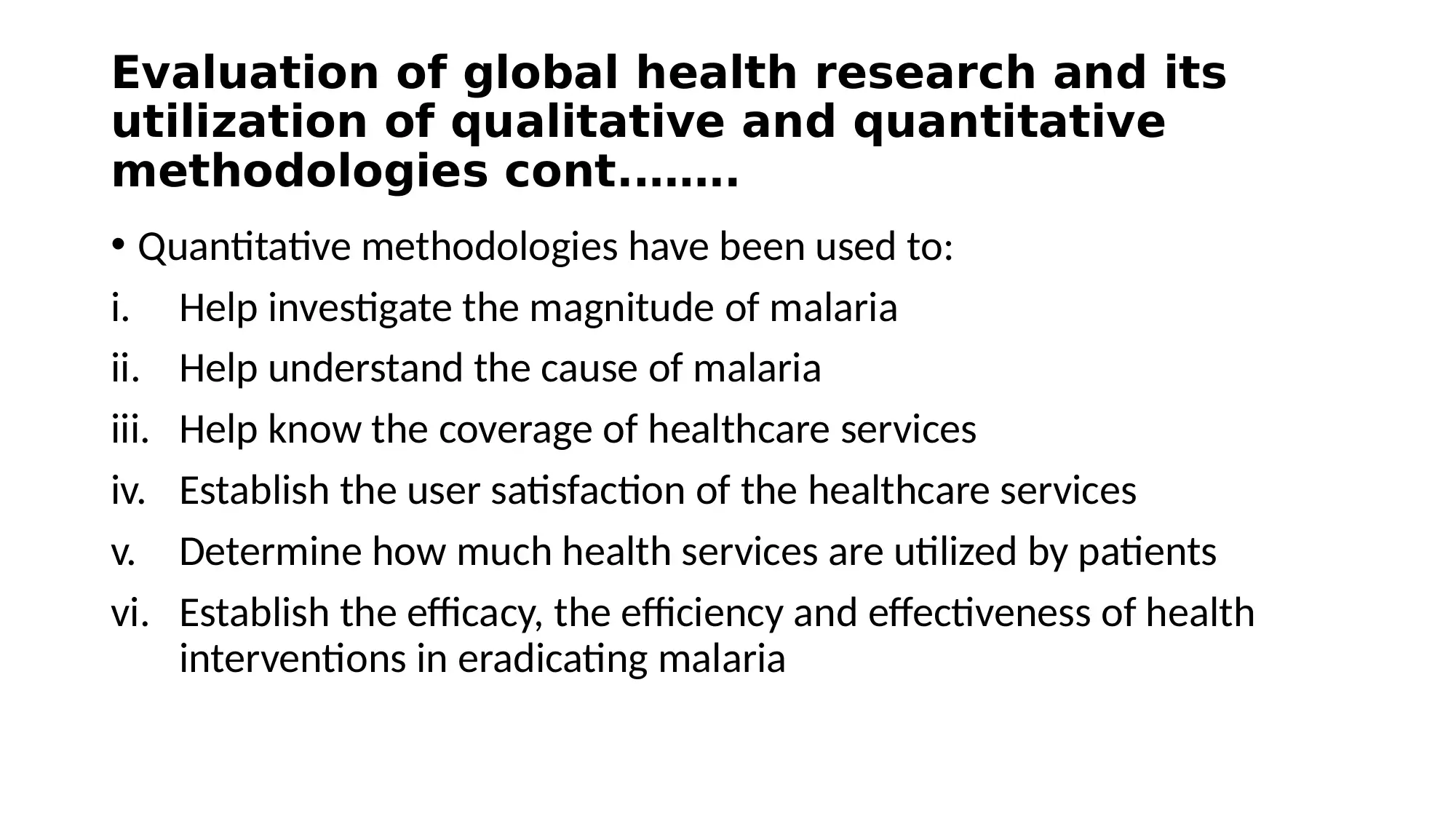
Evaluation of global health research and its
utilization of qualitative and quantitative
methodologies cont.…….
• Quantitative methodologies have been used to:
i. Help investigate the magnitude of malaria
ii. Help understand the cause of malaria
iii. Help know the coverage of healthcare services
iv. Establish the user satisfaction of the healthcare services
v. Determine how much health services are utilized by patients
vi. Establish the efficacy, the efficiency and effectiveness of health
interventions in eradicating malaria
utilization of qualitative and quantitative
methodologies cont.…….
• Quantitative methodologies have been used to:
i. Help investigate the magnitude of malaria
ii. Help understand the cause of malaria
iii. Help know the coverage of healthcare services
iv. Establish the user satisfaction of the healthcare services
v. Determine how much health services are utilized by patients
vi. Establish the efficacy, the efficiency and effectiveness of health
interventions in eradicating malaria

Evaluation of global health research and its
utilization of qualitative and quantitative
methodologies cont.……
• Qualitative methodologies have been used to:
i. Analyze complex social and health policies regarding Malaria
ii. Understand health behaviors concerning Malaria and provide
explanation
iii. Establish the users viewpoint to the accessibility and quality of
healthcare
iv. Understand the styles and cultures in health care services
management
utilization of qualitative and quantitative
methodologies cont.……
• Qualitative methodologies have been used to:
i. Analyze complex social and health policies regarding Malaria
ii. Understand health behaviors concerning Malaria and provide
explanation
iii. Establish the users viewpoint to the accessibility and quality of
healthcare
iv. Understand the styles and cultures in health care services
management
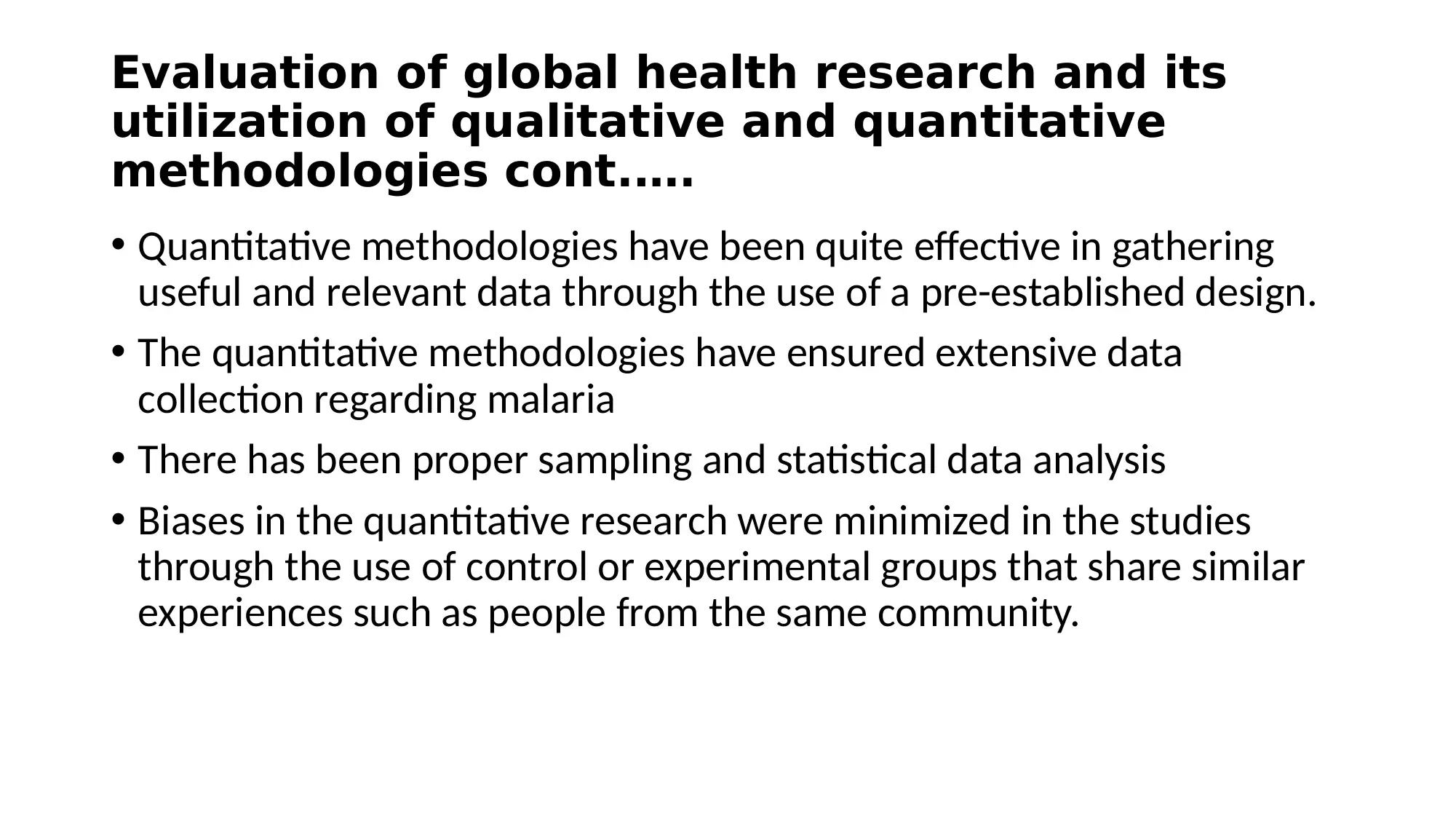
Evaluation of global health research and its
utilization of qualitative and quantitative
methodologies cont.….
• Quantitative methodologies have been quite effective in gathering
useful and relevant data through the use of a pre-established design.
• The quantitative methodologies have ensured extensive data
collection regarding malaria
• There has been proper sampling and statistical data analysis
• Biases in the quantitative research were minimized in the studies
through the use of control or experimental groups that share similar
experiences such as people from the same community.
utilization of qualitative and quantitative
methodologies cont.….
• Quantitative methodologies have been quite effective in gathering
useful and relevant data through the use of a pre-established design.
• The quantitative methodologies have ensured extensive data
collection regarding malaria
• There has been proper sampling and statistical data analysis
• Biases in the quantitative research were minimized in the studies
through the use of control or experimental groups that share similar
experiences such as people from the same community.
Paraphrase This Document
Need a fresh take? Get an instant paraphrase of this document with our AI Paraphraser
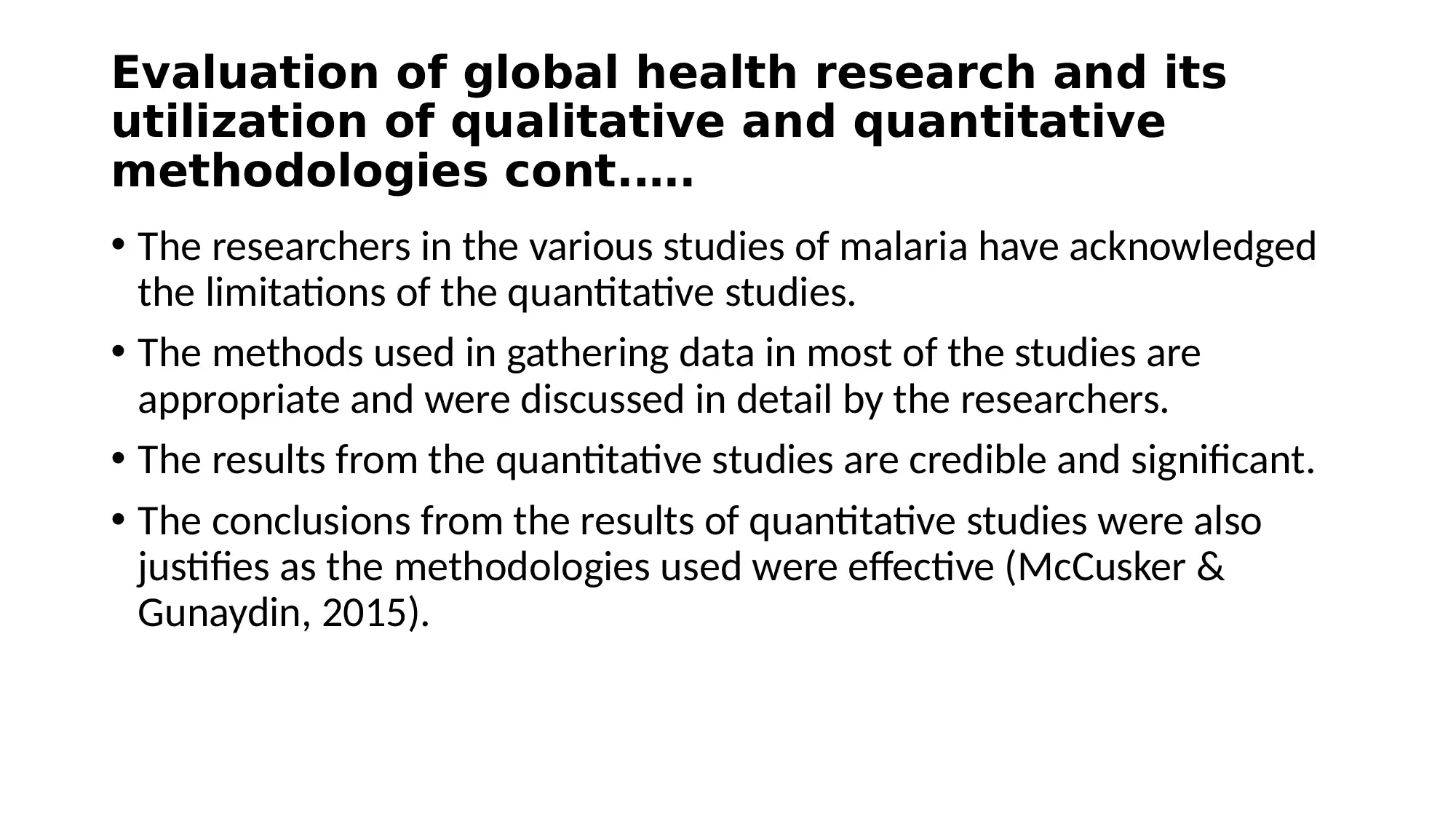
Evaluation of global health research and its
utilization of qualitative and quantitative
methodologies cont.….
• The researchers in the various studies of malaria have acknowledged
the limitations of the quantitative studies.
• The methods used in gathering data in most of the studies are
appropriate and were discussed in detail by the researchers.
• The results from the quantitative studies are credible and significant.
• The conclusions from the results of quantitative studies were also
justifies as the methodologies used were effective (McCusker &
Gunaydin, 2015).
utilization of qualitative and quantitative
methodologies cont.….
• The researchers in the various studies of malaria have acknowledged
the limitations of the quantitative studies.
• The methods used in gathering data in most of the studies are
appropriate and were discussed in detail by the researchers.
• The results from the quantitative studies are credible and significant.
• The conclusions from the results of quantitative studies were also
justifies as the methodologies used were effective (McCusker &
Gunaydin, 2015).
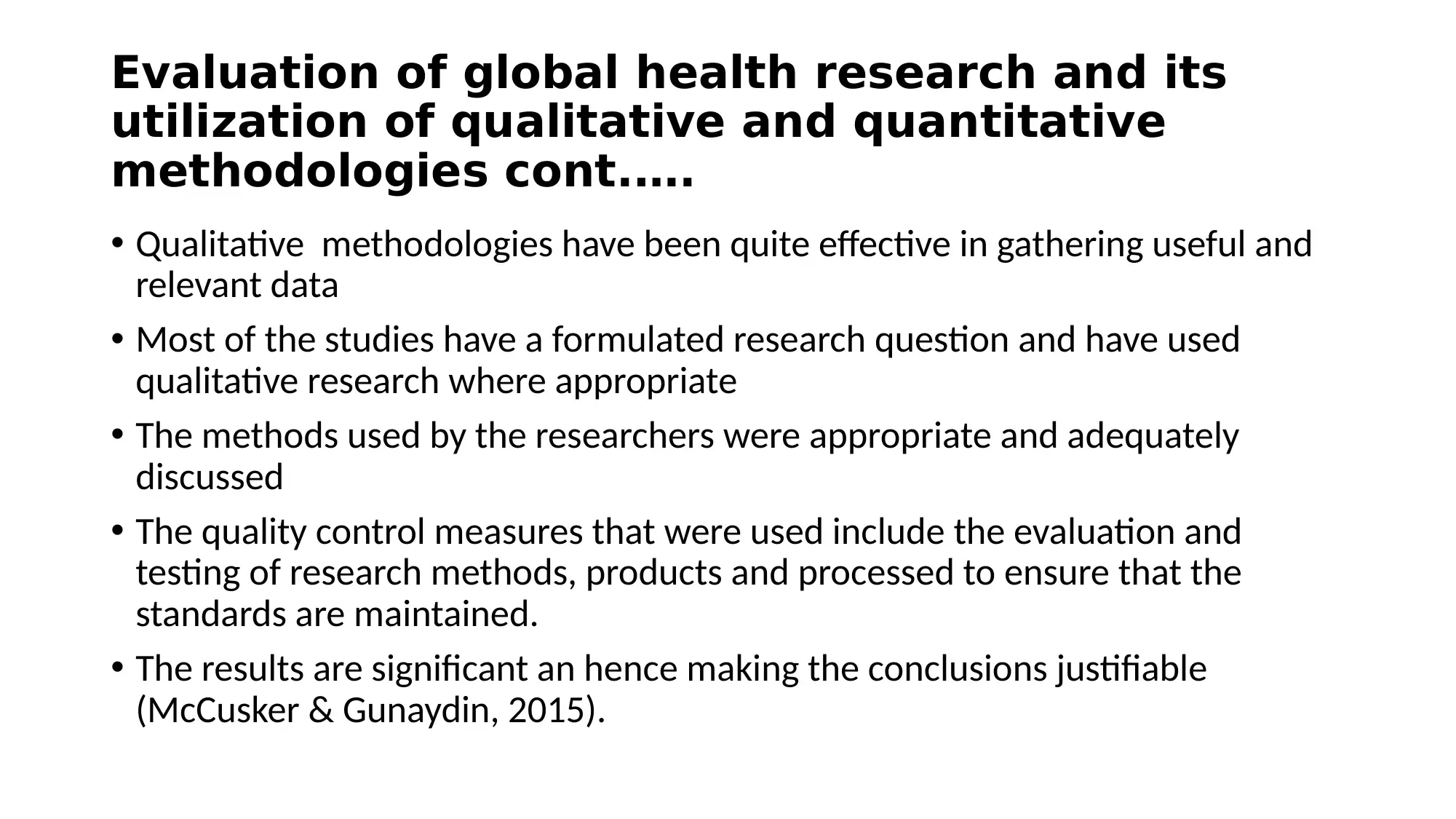
Evaluation of global health research and its
utilization of qualitative and quantitative
methodologies cont.….
• Qualitative methodologies have been quite effective in gathering useful and
relevant data
• Most of the studies have a formulated research question and have used
qualitative research where appropriate
• The methods used by the researchers were appropriate and adequately
discussed
• The quality control measures that were used include the evaluation and
testing of research methods, products and processed to ensure that the
standards are maintained.
• The results are significant an hence making the conclusions justifiable
(McCusker & Gunaydin, 2015).
utilization of qualitative and quantitative
methodologies cont.….
• Qualitative methodologies have been quite effective in gathering useful and
relevant data
• Most of the studies have a formulated research question and have used
qualitative research where appropriate
• The methods used by the researchers were appropriate and adequately
discussed
• The quality control measures that were used include the evaluation and
testing of research methods, products and processed to ensure that the
standards are maintained.
• The results are significant an hence making the conclusions justifiable
(McCusker & Gunaydin, 2015).
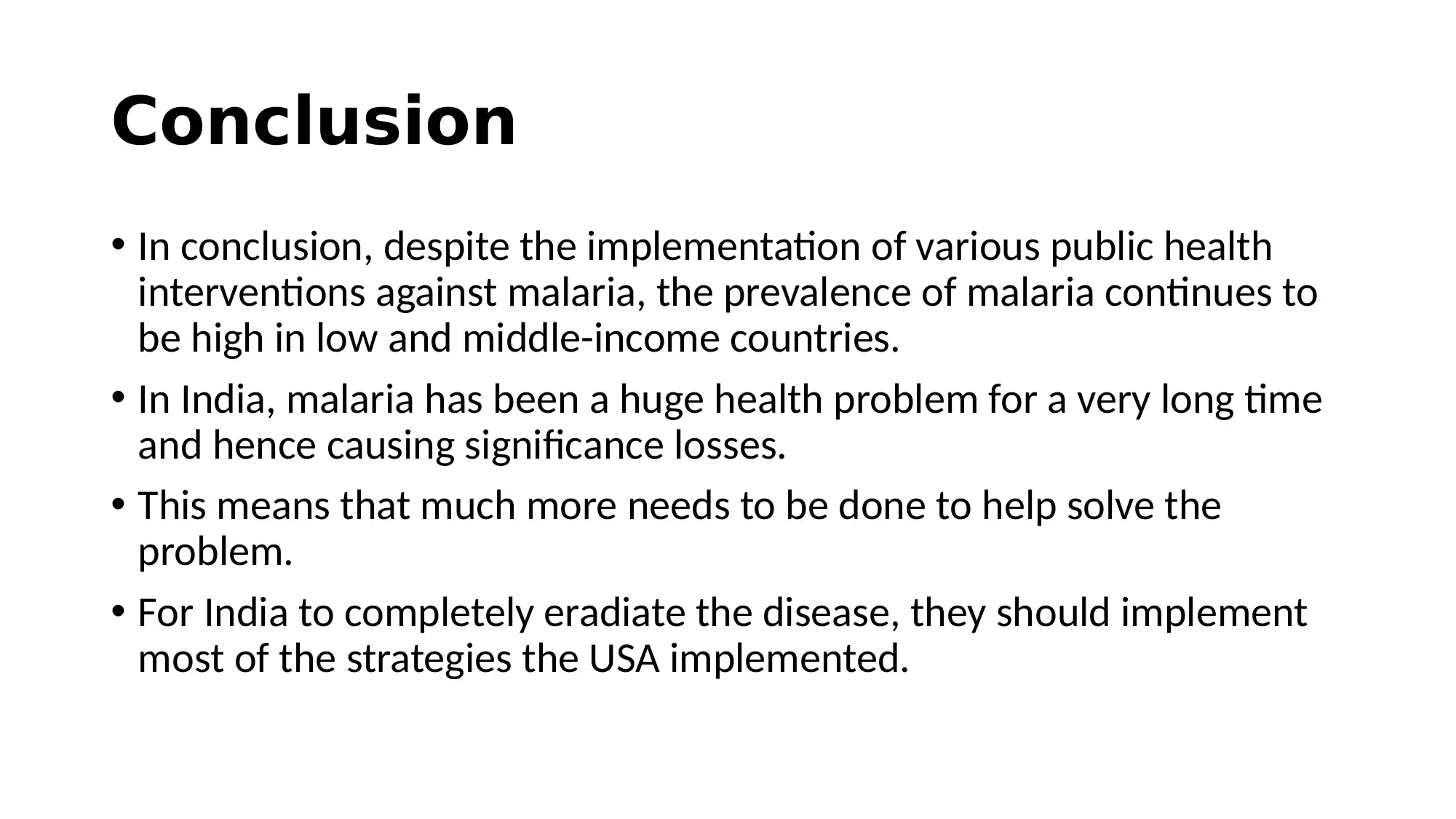
Conclusion
• In conclusion, despite the implementation of various public health
interventions against malaria, the prevalence of malaria continues to
be high in low and middle-income countries.
• In India, malaria has been a huge health problem for a very long time
and hence causing significance losses.
• This means that much more needs to be done to help solve the
problem.
• For India to completely eradiate the disease, they should implement
most of the strategies the USA implemented.
• In conclusion, despite the implementation of various public health
interventions against malaria, the prevalence of malaria continues to
be high in low and middle-income countries.
• In India, malaria has been a huge health problem for a very long time
and hence causing significance losses.
• This means that much more needs to be done to help solve the
problem.
• For India to completely eradiate the disease, they should implement
most of the strategies the USA implemented.
Secure Best Marks with AI Grader
Need help grading? Try our AI Grader for instant feedback on your assignments.
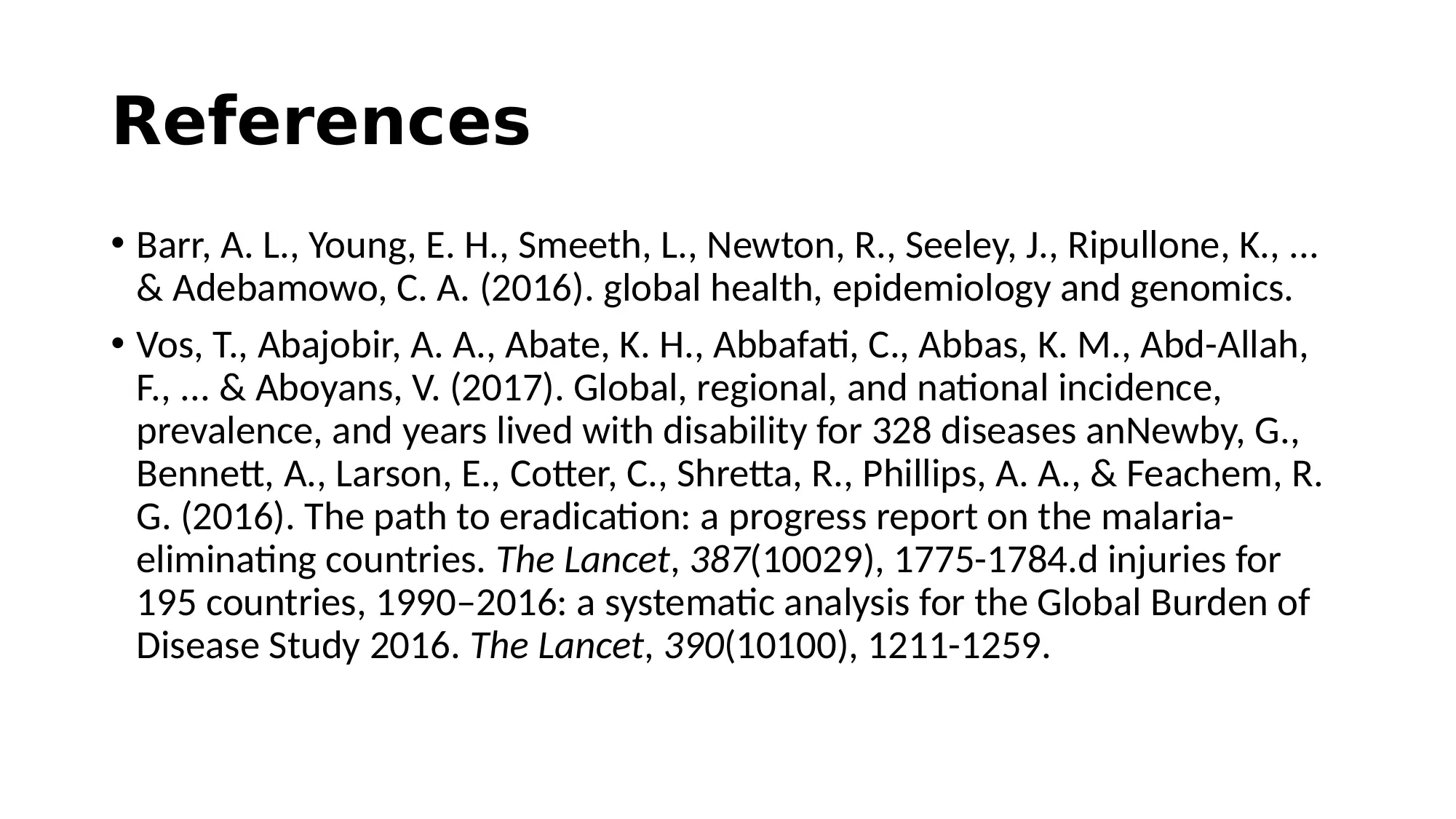
References
• Barr, A. L., Young, E. H., Smeeth, L., Newton, R., Seeley, J., Ripullone, K., ...
& Adebamowo, C. A. (2016). global health, epidemiology and genomics.
• Vos, T., Abajobir, A. A., Abate, K. H., Abbafati, C., Abbas, K. M., Abd-Allah,
F., ... & Aboyans, V. (2017). Global, regional, and national incidence,
prevalence, and years lived with disability for 328 diseases anNewby, G.,
Bennett, A., Larson, E., Cotter, C., Shretta, R., Phillips, A. A., & Feachem, R.
G. (2016). The path to eradication: a progress report on the malaria-
eliminating countries. The Lancet, 387(10029), 1775-1784.d injuries for
195 countries, 1990–2016: a systematic analysis for the Global Burden of
Disease Study 2016. The Lancet, 390(10100), 1211-1259.
• Barr, A. L., Young, E. H., Smeeth, L., Newton, R., Seeley, J., Ripullone, K., ...
& Adebamowo, C. A. (2016). global health, epidemiology and genomics.
• Vos, T., Abajobir, A. A., Abate, K. H., Abbafati, C., Abbas, K. M., Abd-Allah,
F., ... & Aboyans, V. (2017). Global, regional, and national incidence,
prevalence, and years lived with disability for 328 diseases anNewby, G.,
Bennett, A., Larson, E., Cotter, C., Shretta, R., Phillips, A. A., & Feachem, R.
G. (2016). The path to eradication: a progress report on the malaria-
eliminating countries. The Lancet, 387(10029), 1775-1784.d injuries for
195 countries, 1990–2016: a systematic analysis for the Global Burden of
Disease Study 2016. The Lancet, 390(10100), 1211-1259.

References cont.….
• Harris, M. J. (2016). Evaluating public and community health
programs. John Wiley & Sons.
• Newby, G., Bennett, A., Larson, E., Cotter, C., Shretta, R., Phillips, A. A.,
& Feachem, R. G. (2016). The path to eradication: a progress report
on the malaria-eliminating countries. The Lancet, 387(10029), 1775-
1784.
• Winskill, P., Slater, H. C., Griffin, J. T., Ghani, A. C., & Walker, P. G.
(2017). The US President's Malaria Initiative, Plasmodium falciparum
transmission and mortality: A modelling study. PLoS medicine, 14(11),
e1002448.
• Harris, M. J. (2016). Evaluating public and community health
programs. John Wiley & Sons.
• Newby, G., Bennett, A., Larson, E., Cotter, C., Shretta, R., Phillips, A. A.,
& Feachem, R. G. (2016). The path to eradication: a progress report
on the malaria-eliminating countries. The Lancet, 387(10029), 1775-
1784.
• Winskill, P., Slater, H. C., Griffin, J. T., Ghani, A. C., & Walker, P. G.
(2017). The US President's Malaria Initiative, Plasmodium falciparum
transmission and mortality: A modelling study. PLoS medicine, 14(11),
e1002448.

References cont.….
• Mace, K. E., Arguin, P. M., & Tan, K. R. (2018). Malaria Surveillance—
United States, 2015. MMWR Surveillance Summaries, 67(7), 1.
• Wangdi, K., Gatton, M. L., Kelly, G. C., Banwell, C., Dev, V., & Clements,
A. C. (2016). Malaria elimination in India and regional
implications. The Lancet infectious diseases, 16(10), e214-e224.
• Steketee, R. W., & Nahlen, B. L. (2017). The Future of Measuring
Impact against Malaria: From Saving Lives to Eliminating
Transmission. The American journal of tropical medicine and
hygiene, 97(3_Suppl), 3-5.
• Mace, K. E., Arguin, P. M., & Tan, K. R. (2018). Malaria Surveillance—
United States, 2015. MMWR Surveillance Summaries, 67(7), 1.
• Wangdi, K., Gatton, M. L., Kelly, G. C., Banwell, C., Dev, V., & Clements,
A. C. (2016). Malaria elimination in India and regional
implications. The Lancet infectious diseases, 16(10), e214-e224.
• Steketee, R. W., & Nahlen, B. L. (2017). The Future of Measuring
Impact against Malaria: From Saving Lives to Eliminating
Transmission. The American journal of tropical medicine and
hygiene, 97(3_Suppl), 3-5.
Paraphrase This Document
Need a fresh take? Get an instant paraphrase of this document with our AI Paraphraser
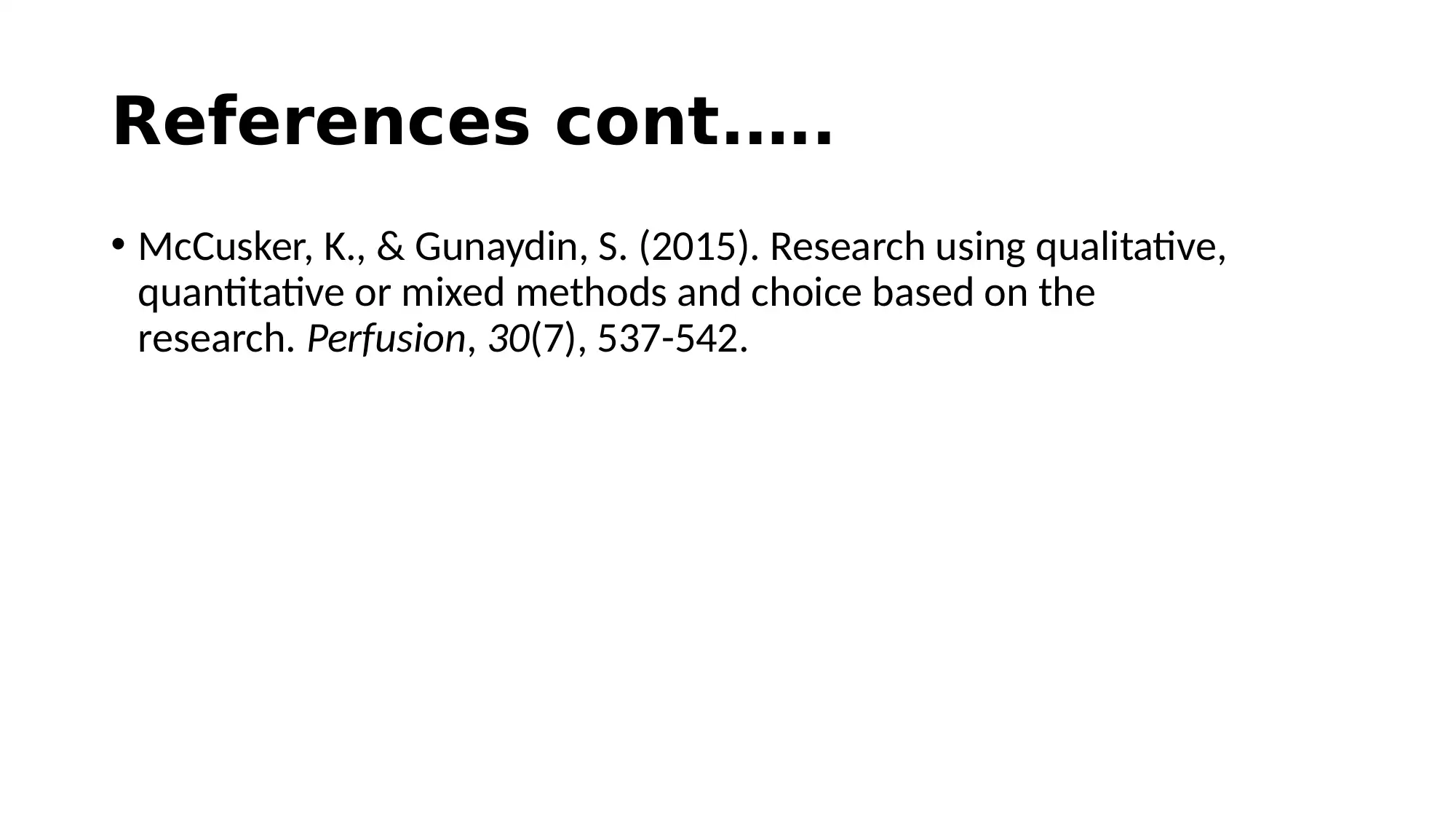
References cont.….
• McCusker, K., & Gunaydin, S. (2015). Research using qualitative,
quantitative or mixed methods and choice based on the
research. Perfusion, 30(7), 537-542.
• McCusker, K., & Gunaydin, S. (2015). Research using qualitative,
quantitative or mixed methods and choice based on the
research. Perfusion, 30(7), 537-542.
1 out of 26
Related Documents
Your All-in-One AI-Powered Toolkit for Academic Success.
+13062052269
info@desklib.com
Available 24*7 on WhatsApp / Email
![[object Object]](/_next/static/media/star-bottom.7253800d.svg)
Unlock your academic potential
© 2024 | Zucol Services PVT LTD | All rights reserved.





